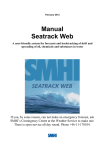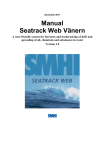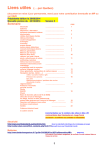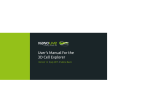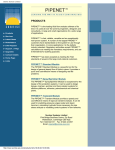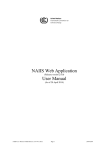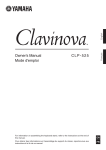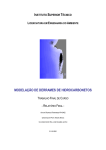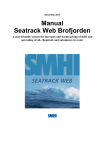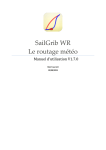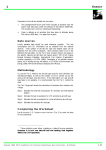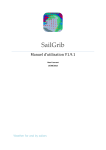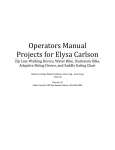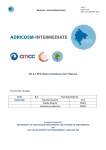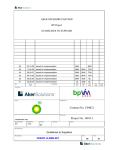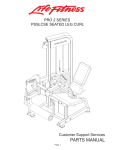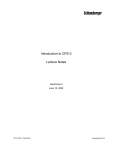Download BS WEB Track - Black Sea Mrcc
Transcript
January 2011 Manual BlackSeatrack Web A user-friendly system for forecasts, backtracking and presentation of spreading of oil, chemicals and substances in water Version 1 If you, by some reason, cannot make an emergency forecast, ask Permanent Secretariat Commission on the Protection of the Black Sea Against Pollution (Bucharest Convention), Fatih Orman Kampüsü, Büyükdere Caddesi, No 265, 34398 Maslak/ Şişli – Istanbul, TURKEY Tel: +90 212 299 2940, +90 212 299 1 Introduction and Background ..................................................................3 1.1 1.2 1.3 The circulation model ............................................................................................ 3 The weather models ............................................................................................... 3 Ice information ....................................................................................................... 4 2 Installation of BlackSeatrack Web ...........................................................5 2.1 2.2 2.3 2.4 System Requirements............................................................................................. 5 Enter the Internet address....................................................................................... 5 How to make proxy settings in Java Web start ...................................................... 5 To look at the java console to know what is going wrong ..................................... 6 3 Start and Stop BlackSeatrack Web ..........................................................7 3.1 3.2 Start ........................................................................................................................ 7 Stop ........................................................................................................................ 7 4 The graphical user interface .....................................................................8 4.1 4.2 Menu in the upper frame ........................................................................................ 8 Tool buttons for controlling the map view and starting a calculation................. 11 5 Choose calculation parameters and start a calculation ........................12 5.1 5.2 5.3 5.4 5.5 5.6 5.7 5.8 5.9 5.10 Time & Position ................................................................................................... 12 Substance ............................................................................................................. 13 Discharge ............................................................................................................. 14 Scenarios .............................................................................................................. 15 Calculation options .............................................................................................. 15 Calculation info.................................................................................................... 16 Default values ...................................................................................................... 16 Compute/Cancel/Stop .......................................................................................... 16 Stop ...................................................................................................................... 16 Common Information........................................................................................... 16 6 The calculation is ready ...........................................................................17 6.1 6.2 6.3 6.4 6.5 Visualisation of the result .................................................................................... 17 Plot the wind and the surface currents ................................................................. 18 Save a case ........................................................................................................... 19 Start a continued case........................................................................................... 19 Print/plot the results ............................................................................................. 20 7 Support ......................................................................................................21 8 Error and warning messages...................................................................21 9 Annex 1 AIS (Automatic Identification System) Shiptracks................23 10 Annex 2 Satellite detections .....................................................................24 1 Introduction and Background BlackSeatrack Web (BSTW) is created by Marine Hydrophysical Institute (MHI) in close cooperation with Swedish Meteorological and Hydrological Institute (SMHI) and Danish Hydraulic Institute (DHI) by request of the Black Sea Commission (BSC). BlackSeatrack Web is based on the Seatrack Web system developed by SMHI, the Danish Maritime Safety Administration, Bundesamt fur Seeshifffart und Hafen and the Finnish Environment Institute for the oil spill forecasting in the Baltic Sea. BlackSeatrack Web’s main purpose is to calculate the spreading of oil in the all basin of the Black Sea. The program can also be used for other substances than oil, such as chemicals, algae and objects. BlackSeatrack Web is also developed further to be a well functioning tool for authorities responsible for oil spill response in the Black Sea. In addition to an oil drift forecast, it is possible to make a backward calculation. Then a calculation starts at the position where a substance was found. The programme calculates the drift backwards in time and traces the origin of the substance or an object. 1.1 The circulation model When you login at BlackSeatrack Web you have access to forecasted current fields of the MHI model of MyOcean Black Sea MFC, which is a 3-dimensional circulation model covering the whole Black Sea (http://www.myocean.eu/web/19-products-andservices.php). The forecasts are made daily and up to 3 days (to 5 days from August 2011) forecasts are included into BlackSeatrack Web. Every 1 hour new current fields are used in BlackSeatrack Web. The horizontal grid resolution is 0.06110 along longitude and 0.04440 along latitude (approximately 5 km). The MHI model uses 35 different depth levels up to bottom, it assimilates sea level anomaly provided by AVISO/Altimetry a multi-satellite data active archive center (France) and SST obtained via direct reception of AVHRR. Surface wave dynamics is simulated by WAM which is coupled with the circulation model. In BlackSeatrack Web the forecasted currents can be plotted gives the currents at 20 depth levels up to 300 m and that influence the drift and spreading of the substance. 1.2 The weather models The atmospheric forcing on the sea surface is specified by the high resolution regional atmospheric model operated in the real-time by the National Meteorological Administration (NMA) of Romania (http://www.meteoromania.ro) based on MeteoFrance ALADIN family or by the SKIRON forecasting system of Atmospheric Modelling and Weather Forecasting Group (AM&WFG), which is part of School of Physics and the Institute of Accelerating Systems and Applications (IASA) of National and Kapodistrian University of Athens (http://forecast.uoa.gr/). 3 The wind forecasts used in BlackSeatrack Web are from 10 meters height. The user should be aware that smaller scale and local wind effects are not included into the BlackSeatrack Web drift calculations. The forecasted wind can be plotted. 1.3 Ice information Ice and oil interaction has been introduced in Seatrack Web. But because the ice cover in the Black Sea is very rare and the accuracy of the forecasted ice cover is enhanced by daily assimilation of ice observations, the interaction with ice is not included in this BlackSeatrack Web version. Although in the future it is possible. 4 2 Installation of BlackSeatrack Web 2.1 System Requirements PC-compatible Pentium 700 MHz 2 Mb video-memory, 17’’(1024x768) screen, 512 Mb RAM, Firefox, Chrome, Opera or Internet Explorer (minimum version 7.0). Java version > 1.5 You may download the last version at http://www.java.com Internet connection is needed and should be at least at the xDSL level. A reasonable transfer speed is minimum 256 kilobit/sec. 2.2 Enter the Internet address Enter the Internet address http://bscpsecretariat.no-ip.org:8080/seatrack/ in your Web browser. 2.3 How to make proxy settings in Java Web start 1. Start Java Webstart from the icon on your desktop or from the start menu. 2. Choose "File" and "Preferences", if nothing is happening, please wait…. 3. … preferences dialog should appear on screen: 5 Change the proxy settings to your server and port; also add server exceptions if you have any, then press OK. 4. Quit Java Webstart 5. Restart the computer 6. Start BlackSeatrack. 2.4 To look at the java console to know what is going wrong 1. Choose File Explorer and go to the file where the java program is installed on your system Example paths: C:\Program\Java\jre1.6.0_02\bin C:\Program\Java\j2re1.4.2_05\javaws C:\Program Files\Java\jre1.5.0_03 Could be any other path depending on where you initially installed java. 2. Double-click on javaws.exe, and the Java Web Start – application manager starts 3. Go in below 'File -> Settings' or 'Edit -> Settings' 4. Choose Advanced 5. Click in Show (Visa) Java-system window (Java-console) and press OK, Ready! Alternative 2-4, instead of 2-5 above. 2. Double-click on javacpl.exe and you come to Java control panel 3. Choose Advanced 4. Click on Java consol and choose Show consol, press Apply and then OK. 6 3 Start and Stop BlackSeatrack Web 3.1 Start Enter the Internet address, which is http://bscpsecretariat.no-ip.org:8080/seatrack/ in your Web browser. The manual is found by clicking ‘User manual’. Also ‘Technical Documentation’ is here. For support, click ‘Contact’, Figure 1. Press ‘Start Seatrack Web’, write User and Password, press Login and the map in Figure 2 appears. Figure 1.The BlackSeatrack Web start page with BlackSeatrack user news. 3.2 Stop If you want to stop BlackSeatrack Web, go to ‘File’ and click ‘Exit’. 7 4 The graphical user interface Figure 2. Map over the area. 4.1 Menu in the upper frame The menu in BlackSeatrack Web is similar to the windows system, with some choices at the top of the screen. At the top frame are File, View, Layer and About. File gives the following options: Open Case- when you want to open an existing calculated case. Save Case- when you want to save a calculated case. When Save is done you choose the directory yourself. The name of the case must have suffix .xml if you have Java 1.6 or higher. Save Map as image – saves the map in a jpg format. Email map image - mails the map. Read Bohuslan info - especially for Seatrack Web, no enabled. Download Bohuslan data - especially for Seatrack Web, no enabled. Change password Load AIS data – especially for those having access to AIS data, now no enabled. Clear AIS data - especially for those having access to AIS data, now no enabled. See Annex 1. Load algae data – a special file from satellite detections of algae in the sea. Example of algae data in the Baltic Sea you can see on the picture below. This option does not 8 include now in the BlackSeatrack Web. Example of algae data detected from satellite for the Baltic Sea. Clear algae data- now no enabled Satellite detections of oil spills, see Annex 2 - now no enabled Exit View gives the following options: Available files –shows which period you can make oil drift forecast with MyOcean Black Sea MFC model. Forecasted currents and winds are generated every hour and available 30 days back in time from today at 00.00. AIS information, see Annex1, now no enabled. Available AIS data files, now no enabled. AIS ships, now no enabled. Ship info, now no enabled. Input data shows what parameters you have chosen for the calculation. Results table shows weathering properties, volume, viscosity, density, wind and current data. They can be plotted automatically by your own choice. 9 Layer, Show/hide layer selection gives the following options When this check box is selected a label for each selected layer is shown. Name & Time & Layer description means the grey square in the upper left corner of the map, showing the name of the calculation, the time it is made and the time of the result, see below. Static layers Graphics, makes it possible to draw green lines anywhere in the map Lat/lon grid, plot the latitude and longitude grid Boundary for Territorial waters, shows this border for all countries Base line, shows this border along the Black Sea coast Cities and countries, names Country borders Important Bird Areas, IBA, no enable now Major ship routes, no enable now Ship traffic separation, no enable now Dynamic layers no enable now About About BlackSeatrack Web Credits to people 10 4.2 Tool buttons for controlling the map view and starting a calculation Arrow shows an arrow where the cursor is. Zoom is a zooming tool, it is important that the area chosen has the cursor/cross in the lower right corner and not further down in the map. Otherwise another area is zoomed. Center symbol gives the possibility to move the map on the screen, where you put the symbol, the new center will appear Zoom in gives one step zoom every time you click in the map Zoom out gives one step zoom out for every click in the map Maximize scale in current window, gives the whole map back. Set map scale, choose your own scale and center point, Scale, Center (lower left) shows your scale and centre point. If you later want to have the same map area. Add, edit or delete text on map, the text can be moved in the map Draw lines draw a green line, take away by doubleclick Distance shows the distance in nautical miles and bearing (angle measured clockwise from north) below the map. You stop this by a double-click Show/hide layer selection open/close the window with the GIS layers. Model choice, MyOcean Black Sea MFC model for all basin or nested grid coastal model (now no enabled). 11 New Case, go to the Calculation Parameters. See figure 3. Continued Case, continue a calculation, which is made before. A default stop time is suggested, giving one more day, it can be changed, check that data exist below View. You can also continue a calculation that has been made earlier and saved in Save case below File, then go to File and press Open Case. You are asked where the saved file is, and copy it. Make outlet, the red star is default in the cursor, when starting a calculation. Choose Point (1 position), Line (2-4 positions) or Area (3-4 positions). Fetch the red star symbol when you want to mark the outlet position. Doubleclick to give the outlet positions. It is possible to move the corners of the spot with the mouse. If you click more points then you have chosen, the positions are deleted. The rest of the buttons in the upper frame are active when you have a calculated case. Delete case, a cross, return to default settings when a calculation is made. Position information (lower left) you can see any position when moving the cursor in the map. Scale, Centre (lower left) shows your scale and centre point of the map. 5 Choose calculation parameters and start a calculation 5.1 Time & Position Figure 3. Kind of calculation, start and stop time, start positions and outlet depth. 12 Forward calculation, make a forecast up to 5 days ahead and start 30 days back in time. Here you can see which models you have chosen. Default of Stop time is always tomorrow at 24.00 UTC even though there are more days, this is changed manually. Start time is always present time UTC, Coordinated Universal Time. Backward calculation, make a calculation backwards in time, to find the place where the oil or object comes from. The Start time now has to be ‘later’ than the Stop time. Start position is given as degrees, minutes and decimals of minutes. Pay attention, not minutes and seconds. If you have clicked this directly in the map, it is shown here. You can change here if needed. If you make a dot, line, triangle or square then all the points must be located on land. In the next versions of the system the possibility of setting of some points on land if at least one of them is situated in the sea will be included. If you make a dot, line, triangle or square then some of the points can be on land if at least one of them is situated in the sea, see Figure 4. Figure 4. Outlet specified by a triangular area which partly covers land. Outlet depth is the initial depth of the spill. The depth is given in meters, decimals are possible. 5.2 Substance In Oil classes there are 3 different viscosity intervals, Light, Medium and Heavy oils. A choice here is recommended if one does not have information about the oil type. See fig. 5. Choosing one of these gives the default values among the Oils specific below Light: Light Diesel Fuel Medium: Intermediate Oil Heavy: Bunker C. 13 Figure 5. Choice of viscosity range. Below State of oil you have to select state, if it is new oil choose Fresh oil, but if the oil has been in the water for some time, choose Weathered oil. Evaporation and emulsification has stopped at the maximum value for Weathered oil. Below Oil, specific there are first 11 specified oils to be chosen. Most of those are oil ranges (many different oil types), but it is more specific then Oil classes. This is a possibility, when one has more information about the oil. Choose State of oil. When Rebco oil is wanted choose Light-Medium Crude. Three oils emulsify: Light-medium crude, Heavy crude and Bunker C. 2 new heavy oils are introduced in a test phase, Orimulsion (test) and High Viscosity Fuel Oil (test). The knowledge about these oils is limited, and weathering processes are not activated. The densities are fixed to 1020 kg/m3 (Orimulsion) and 1015 kg/m3 (High Viscosity Fuel Oil). Below those oils there are 25 oils from Sintef’s Oil Weathering Model. All emulsify except Sleipner (IKU) and Marine Diesel (IKU). Balder (medium), Ekofisk Blend (medium), Grane (medium), Gullfaks (light), Kristin (light), Norne (medium), Oseberg A (light), Sleipner (light), Statfjord A (light), Ula (light), Valhall (light), Aasgard (light), DUC (light), Siri (light), South Arne (medium), Fuel oil no 6 LS (heavy), IF-180 (heavy), IF-380 (heavy), IF-30 Bunker (medium), Marine diesel (light), IFO 380 Fu Shan Hai (heavy). Oil lumps give 5cm, 10cm or 20cm thickness of the oil from the surface and downwards. Floating object / Algae Floating algae behaves like a Floating object with ‘0 % extra wind drag on object’. Floating algae, file is described above. Floating object with extra wind drag, an object can be partly above the water surface. It is possible to add extra wind drag for the part above the water surface. See Wind drag % Objects/substance can be calculated at a Constant depth or three dimensional spreading as a passive tracer. 5.3 Discharge Instantaneous spill, the Amount is m3 or tonnes. Decimals can be used e.g. 5.7 m3. Continuous spill Total amount/Rate. Decimals can be used e.g. 0.4 m3/hour. 14 Duration of the spill is given in days or hours. 5.4 Scenarios If you want to make scenarios (which has nothing to do with reality), you choose Scenarios with prescribed currents and winds. The time period that is shown in the window is the same as at Time & Position. The user fills in the current and wind every hour or at time steps of one’s own choice. Then by pressing FILL, the hours below the written data are filled with the nearest above information. This gives a possibility to write new currents at fewer time steps than every hour. The Current speed (knots) is the speed in knots. Current Direction (degrees towards) is the direction measured clockwise from north (90 degrees means currents towards east, 180 degrees means currents towards south etc.). Note that the prescribed current will be the same at all locations and at all depths, but varies in time. The Wind speed (m/s) is the speed in m/s. Wind Direction (degrees from) is the direction measured clockwise from north (90 degrees means wind from east, 180 degrees means wind from south etc.). Choose CLEAR to erase all data and then give new ones. To account for the uncertainty in the weather forecast the user can select Add uncertainty which depends on uncertainty in the weather forecasts. When this option is selected the area over which the oil (or substance) is spread during the calculation will increase to reflect the possible spreading of the spill when the uncertainty of the weather forecast is included. Hence, the increased spreading should not be interpreted as a physical process, but as a consequence of the inherent uncertainty in the weather forecast. 5.5 Calculation options Calculation mode gives the possibility to choose Brief: 100 particles, Normal: 500 particles or Detailed: 2000 particles. Sometimes one just needs a forecast very fast 15 then Brief is recommended. At other occasions a very high significance is needed and then many particles will improve the result. This choice, though, can take quite a long time to calculate. Normal is the default value. 5.6 Calculation info Calculation name is the name you want to call the case. This is later written in the grey square in the upper left corner of the map. Other info is of your own choice, but is useful when you want to save the picture of the Calculation parameters by choosing View and Input data. 5.7 Default values Go back to Default values in the Calculation parameters if needed. 5.8 Compute/Cancel/Stop When the parameters are given, press Compute and start the calculation. If you want to go back to the map instead of starting a calculation, choose Cancel. 5.9 Stop When a calculation is going on ‘Calculation status’ shows the hours where the program is. If you want to stop the calculation, press Cancel. 5.10 Common Information Forecasted water temperature and salinity are taken from the MHI model of MyOcean Black Sea MFC and used for viscosity and evaporation. Density is calculated in BlackSeatrack Web based on temperature and salinity. 16 6 The calculation is ready Figure 6. Result showing that the oil stops at the coastline. Figure 6 is shown when a calculation is ready. It shows how the oil stops at the coastline and clearly shows the areas that are threatened. This scale, shown in lower right corner, gives information about the depth intervals where there is oil. Red is at the surface. Green is below the surface and less than 1 meter depth. Yellow is deeper than 1 meter and less than 5 meters. And so on. 6.1 Visualisation of the result These parts of the upper frame are active when a calculation is made. Trajectory ON/OFF– draws a line through the centre positions of the spots every hour. To erase the trajectory click Trajectory again. Time, date and position are written every 15 minute if there is space. If you then zoom, more data will be written. 17 Figure 7. Trajectory in a zoomed area. Trace ON/OFF and Animate – all the results from the forecast are shown automatically once an hour. To the left of Animate is Trace, which means that one sees every 15 minute spot in the same view. The time of the animation is shown in the popup menu to the right. You can stop Animation by clicking Animate again. To look at each spot specifically use Start spot. Choose Step+1 to step 15 minutes in a forward calculation. The choice Step–1 steps one hour backward in a forward calculation. End spot gives the spot of the last time step. Simultaneously one can see the time of the actual spot in the popup menu and at ‘Now showing’ in the information square in the upper left corner of the map. The popup menu can be used instead of the steps. 6.2 Plot the wind and the surface currents Show wind plots the 10 meter wind. In a zoomed area every 5th value is plotted. When you have the full map every arrow is plotted. The scale is given in the upper left corner of the map. Choose the time from which you want the plot. You can only look at a time covered by a made calculation. If you want to look at an earlier made saved 18 calculation, then the data might be taken away and they can not be plotted. The wind can be animated when you animate the oil spill. Click ‘Show wind’ and click ‘Animate’. Show surface currents, plots the surface current, see figure 8. In a zoomed area every 5th value is plotted. The scale is given in the upper left corner of the map. The surface current can be animated when you animate the oil spill. Click ‘Show surface currents’ and click ‘Animate’. The ice can be animated when you animate the oil spill. Click ‘Show ice’ and click ‘Animate’ Figure 8. Surface currents in a zoomed area. 6.3 Save a case Save Case- when you want to save a calculated case. When Save is done you choose the directory yourself. OBS: If you use Java 1.6 or higher you must add .xml suffix after the name of the file you want to save. If you use earlier Java versions you can add it if you want. 6.4 Start a continued case 19 This is chosen when one wants to make a continuation of an earlier made and saved calculation. One must open the earlier executed case if it is not just made and thus is in the computer. Open Case below File in the upper frame. Try to always save in a certain directory. Press Continued Case in the upper frame. Most of the information in the Calculation parameters is given from the earlier executed forecast in the saved case and can therefore not be changed. If the result from an earlier made forecast is verified against observations and there is a discrepancy between the last calculated position and the observation, the starting position can be altered in Centre position by giving new Latitude and Longitude there. New Stop time must be given, as the forecast now is prolonged from the previous forecast. The start time of the Continued Case is the stop time of the previous case and the new stop time is by default one day further ahead. This can be altered. New Other info below Calculation info can be written. 6.5 Print/plot the results File is shown in the upper frame.Save Map as image, save the map on the screen as jpg. Email map as image, mails the map. View is shown in the upper frame. Results table gives all the calculated data in ‘ready to make’ plots.One can see how big part of the oil that is stranded at the shore Oil at shore and how much that is on the sea bed Oil at sea bed. You can make a plot of the oil’s different states by marking the wanted variables and press Create chart down to the left. It is possible to plot the other variables such as viscosity and so on by clicking the wanted variables and press Create chart. If you want to make your own plot, press Export table and save it as a csv file and import it into excel. Or, do as before Ctrl A (select all), Ctrl C (copy), open eg excel and Ctrl V (copy). 20 7 Support Model calculation Alexander Kubryakov, Oceanographer, Email: [email protected] Customer relations, calculation Cecilia Ambjörn, Oceanographer, 011-4958174, 0709-784488. Email : [email protected] System or installation problems Francois-Xavier Thoorens, Application Manager, Email : [email protected] MHI, 2, Kapitanskaya Str., 99011, Sevastopol, Crimea, Ukraine, Phone: +380(692) 547279 SMHI, 60176 Norrköping, Sweden Phone +46-11-4958000, Fax: +46-11-4958001 8 Error and warning messages Error messages, are shown below the map in red letters. Err! Internal input/output error Invalid start or stop time Forward/backward calculation inconsistent with start/stop time Invalid start position Invalid specification of outlet area Outlet on land or outside model domain 21 Invalid substance value or unit Substance not found in oil database In the weathered state all of this volatile oil has evaporated Invalid discharge value or unit Invalid current options value or unit Invalid calculation option Backward calculation not possible for fresh oil Continuous discharge not possible for weathered oil Calculation with floating object requires depth=0 Invalid input data Substance outside boundary Internal error 22 9 Annex 1 AIS (Automatic Identification System) Shiptracks The AIS functionality, as a tool to identify the ship which causes an oil spill, is planned to include in BlackSeatrack Web in the next versions. The AIS function will give the shiptracks in the area where the spill was detected and backwards to its probable origin. By using the shiptracks simultaneously with the oiltracks the probability to indentify a suspected ship increases. 23 10 Annex 2 Satellite detections The option Satellite detections of oil spills is planned to include in BlackSeatrack Web in the next versions and only for those having access to satellite data. 24
























